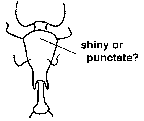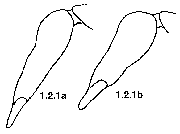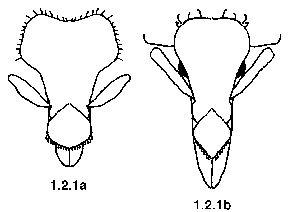
Dacetonini, Myrmicinae, Formicidae, Hymenoptera, Insecta, Arthropoda, Animalia
John T. Longino
The Evergreen State College
Olympia WA 98505 USA
longinoj@evergreen.edu
26 March 1997
| Key to Costa Rican species of Smithistruma and Trichoscapa | Species List |
The dacetonines are a diverse lineage found throughout the world. Many species are known to be strictly predaceous, and all are assumed to be. Most of them have highly modified mandibles relative to the standard triangular mandible common to most other ants. Many have mandibles that are elongate, linear, and with opposing tines at the tip (convergent with other lineages such as Odontomachus in the Ponerinae). Others have elongate mandibles like serrated scissors. Others have serrated mandibles that curve ventrally. Most dacetonines are slow-moving, small, and very cryptic. Most are found in or under rotten wood, and in the leaf litter. Dacetonines are difficult to locate by visual search, but litter sifting followed by extraction in Winkler bags or Berlese funnels often yields abundant material.
The dacetonine genera currently known for Costa Rica are Acanthognathus, Glamyromyrmex, Neostruma, Smithistruma, Strumigenys, and Trichoscapa. I avoid giving details of generic definitions here, because Barry Bolton of the British Museum is currently revising "smithistrumiform" dacetonines, and the generic definitions will change dramatically. One likely change is that Smithistruma will become a junior synonym of Trichoscapa, hence their combination in this document.
Below is a key to the known Costa Rican species of the genera Smithistruma and Trichoscapa. All of the material on which the key was based was sent to Bolton and verified by him.
Earlier keys and references to Smithistruma include:
Brown, W. L., Jr. 1953. Revisionary studies of the ant tribe Dacetini. Am. Mid. Nat. 50:1-137.
Brown, W. L., Jr. 1964. The ant genus Smithistruma: A first
supplement to the World revision (Hymenoptera: Formicidae). Trans.
Am. Entomol. Soc. 89:183-200.
Key to Costa Rican Smithistruma and Trichoscapa
1a. Mandibles in side view curving ventrally: 1.0.1
1b. Mandibles in side view straight: 1.0.2
1.0.1a Face punctate: membranifera
1.0.1b. Face smooth and shining: paradoxa
1.0.2a. Sides of posterior half of mesosoma largely smooth and shining: 1.1
1.0.2b. Sides of posterior half of mesosoma completely and densely punctulate: 1.2

1.1a Anterior border of clypeus relatively more "V"-shaped: alberti
1.1b Anterior border of clypeus more broadly rounded: 1.1.2

1.1.2a Anteromedian section of promesonotum punctate and opaque, not shining; free posterodorsal face of petiolar node considerably broader than long and about 2/3 the length of the free postpetiolar disc: nigrescens
1.1.2b Anteromedian section of promesonotum smooth and shining; free posterodorsal face of petiolar node approximately as long as broad and as long as the free postpetiolar disc: 1.1.2.2


1.1.2.2a Compound eye composed of about 10 facets; setae at anteromedian margin of clypeus very short, not projecting beyond clypeal margin: fridericimuelleri
1.1.2.2b Compound eye composed of about 5 facets; setae at anteromedian margin of clypeus longer, projecting beyond clypeal margin: parsauga
1.2a Head relatively elongate: 1.2.1
1.2b Head relatively shorter: 1.2.2

1.2.1a Petiole lacking ventral spongiform appendages; head very flattened in side view; head relatively less elongate: depressiceps
1.2.1b Petiole with ventral spongiform appendages; head not flattened in side view; head very elongate: probatrix



1.2.2a Ventral appendages of petiole present and distinctly spongiform; infradental lamellae broad, convex below [not observed by me]: epinotalis
1.2.2b Ventral petiolar appendages entirely obsolete or present as very fine cariniform vestiges; infradental lamellae vestigial or narrow and concave: 1.2.2.2


1.2.2.2a Gaster with more than 10 erect, somewhat spoon-shaped setae: 1.2.2.2.1
1.2.2.2b Gaster with 0-4 filiform (not spoon-shaped) erect setae: 1.2.2.2.2

1.2.2.2.1a Propodeal teeth broad at base and continuous with infradental lamellae; gaster with coarse striae on first third: 1.2.2.2.1.1
1.2.2.2.1b Propodeal teeth slender and acutely tapered, their infradental lamellae obsolete and represented only by fine carinae; basal tergite of gaster finely striolate-punctulate over entire surface, with no or very short coarse striae at postpetiolar insertion: margaritae


1.2.2.2.1.1a Cephalic vertex with no differentiated standing hairs, just uniform ground-pilosity; pronotal humeri lack projecting hairs of any description: studiosi
1.2.2.2.1.1b Cephalic vertex with transverse row of 4 - 6 suberect hairs just behind the highest point, these hairs distinctly differentiated from the ground-pilosity; each pronotal humerus with single stout projecting hair: schulzi
1.2.2.2.2a In side view, face distinctly bristly, with numerous short erect setae: 1.2.2.2.2.1
1.2.2.2.2b Face lacking erect setae or with extremely inconspicous, short, subdecumbent setae: microthrix
1.2.2.2.2.1a Surface of face granular but not tuberculate: cassicuspis
1.2.2.2.2.1b Surface of face granular and roughly tuberculate: stauroma

Page author: John T. Longino longinoj@evergreen.edu
Last modified: 26 March1997